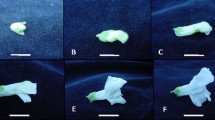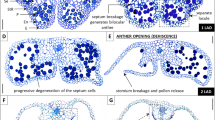Abstract
Delphinium flowers are highly sensitive to ethylene and its sepals abscise during senescence in association with an increase in 1-aminocyclopropane-1-carboxylic acid (ACC) synthase (ACS) and ACC oxidase (ACO) activities and ethylene production in gynoecium and receptacle. Three ACS genes (DgACS1, DgACS2, and DgACS3) and three ACO genes (DgACO1, DgACO2, and DgACO3) of D. grandiflorum cv. Super Grand Blue were cloned. To investigate the contribution of these genes to ethylene production, their expression in the gynoecium and receptacle was analyzed during natural senescence and after ethylene exposure and pollination. Ethylene production in the receptacle significantly increased, whereas that in the gynoecium exhibited only a slight increase during natural senescence. The transcript levels of ACS and ACO in these organs, excluding those of DgACS2 in the receptacle, increased during senescence. Exposure to ethylene accelerated sepal abscission and increased ethylene production more markedly in the receptacle than in the gynoecium. DgACS1 transcript levels in the gynoecium and DgACS2 and DgACO3 transcript levels in the receptacle increased after ethylene exposure. Pollination accelerated sepal abscission and increased ethylene production in the gynoecium and receptacle. Additionally, it slightly affected ACS and ACO transcript levels in the gynoecium, whereas DgACO3 transcript levels in the receptacle markedly increased. These results reveal that ACS and ACO expression is differently regulated in the gynoecium and receptacle. Furthermore, some of these genes are upregulated by pollination only in the receptacle, indicating the significance of the receptacle in ethylene biosynthesis associated with sepal abscission.











Similar content being viewed by others
Data availability
The data that supports the findings of this study are available in the supplementary material of this article.
Abbreviations
- ACC:
-
1-Aminocyclopropane-1-carboxylic acid
- ACO:
-
1-Aminocyclopropane-1-carboxylic acid oxidase
- ACS:
-
1-Aminocyclopropane-1-carboxylic acid synthase
References
Argueso CT, Hansen M, Kieber JJ (2007) Regulation of ethylene biosynthesis. J Plant Growth Regul 26:92–105. https://doi.org/10.1007/s00344-007-0013-5
Brown KM (1997) Ethylene and abscission. Physiol Plant 100:567–576. https://doi.org/10.1111/j.1399-3054.1997.tb03062.x
Clark DG, Richards C, Hilioti Z, Lind-Iversen S, Brown K (1997) Effect of pollination on accumulation of ACC synthase and ACC oxidase transcripts, ethylene production and flower petal abscission in geranium (Pelargonium × hortorum L.H. Bailey). Plant Mol Biol 34:855–865. https://doi.org/10.1023/A:1005877809905
Do YY, Thay TS, Chang TW, Huang PL (2005) Molecular cloning and characterization of a novel 1-aminocyclopropane-1-carboxylate oxidase gene involved in ripening of banana fruits. J Agric Food Chem 53:8239–8247. https://doi.org/10.1021/jf051224+
Gillisen LJW, Hoekstra FA (1984) Pollination-induced corolla wilting in Petunia hybrida rapid transfer through the style of a wilting-inducing substance. Plant Physiol 75:496–498. https://doi.org/10.1104/pp.75.2.496
Goto R, Aida R, Shibata M, Ichimura K (1999) Role of ethylene on flower senescence of Torenia. J Jpn Soc Hort Sci 68:263–268. https://doi.org/10.2503/jjshs.68.263
Hilioti Z, Richards C, Brown KM (2000) Regulation of pollination-induced ethylene and its role in petal abscission of Pelargonium × hortorum. Physiol Plant 109:322–332. https://doi.org/10.1034/j.1399-3054.2000.100314.x
Houben M, Van de Poel B (2019) 1-Aminocyclopropane-1-carboxylic acid oxidase (ACO): the enzyme that makes the plant hormone ethylene. Front Plant Sci 10:695. https://doi.org/10.3389/fpls.2019.00695
Hsieh YC, Sacalis J (1986) Levels of ACC in various floral portions during aging of cut carnations. J Am Soc Hort Sci 111:942–944
Ichimura K, Goto R (2000) Acceleration of senescence by pollination of cut ‘Asuka-no-nami’ Eustoma flowers. J Jpn Soc Hort Sci 69:166–170. https://doi.org/10.2503/jjshs.69.166
Ichimura K, Shimamura M, Hisamatsu T (1998) Role of ethylene in senescence of cut Eustoma flowers. Postharvest Biol Technol 14:193–198. https://doi.org/10.1016/S0925-5214(98)00039-8
Ichimura K, Kohata K, Goto R (2000) Soluble carbohydrate in Delphinium and their influence on sepal abscission in cut flowers. Physiol Plant 108:307–313. https://doi.org/10.1034/j.1399-3054.2000.108003307.x
Ichimura K, Shimizu-Yumoto H, Goto R (2009) Ethylene production by the gynoecium and receptacle is associated with sepal abscission in cut Delphinium flowers. Postharvest Biol Technol 52:267–272. https://doi.org/10.1016/j.postharvbio.2008.12.008
Jackson MB, Campbell DJ (1975) Movement of ethylene from roots to shoots, a factor in the responses of tomato plants to waterlogged soil conditions. New Phytol 74:397–406. https://doi.org/10.1111/j.1469-8137.1975.tb01350.x
Jones ML (2003) Ethylene biosynthetic genes are differentially regulated by ethylene and ACC in carnation styles. Plant Growth Regul 40:129–138. https://doi.org/10.1023/A:1024241006254
Jones ML, Woodson WR (1997) Pollination-induced ethylene in carnation. Role of stylar ethylene in corolla senescence. Plant Physiol 115:205–212. https://doi.org/10.1104/pp.115.1.205
Jones ML, Woodson WR (1999) Differential expression of three members of the 1-aminocyclopropane-1-carboxylate synthase gene family in carnation. Plant Physiol 119:755–764. https://doi.org/10.1104/pp.119.2.755
Kende H (1993) Ethylene biosynthesis. Annu Rev Plant Physiol Mol Biol 44:283–307. https://doi.org/10.1146/annurev.pp.44.060193.001435
Kuroda S, Hakata M, Hirose Y, Shiraishi M, Abe S (2003) Ethylene production and enhanced transcription of an ethylene receptor gene, ERS1, in Delphinium during abscission of florets. Plant Physiol Biochem 41:812–820. https://doi.org/10.1016/S0981-9428(03)00115-3
Kuroda S, Hirose Y, Shiraishi M, Davies E, Abe S (2004) Co-expression of an ethylene receptor gene, ERS1, and ethylene signaling regulator gene, CTR1, in Delphinium during abscission of florets. Plant Physiol Biochem 42:745–751. https://doi.org/10.1016/j.plaphy.2004.07.006
Lee MM, Lee SH, Park KY (1997) Effects of spermine on ethylene biosynthesis in cut carnation (Dianthus caryophyllus L.) flowers during senescence. J Plant Physiol 151:68–73. https://doi.org/10.1016/S0176-1617(97)80038-7
Lin Z, Zhong S, Grierson D (2009) Recent advances in ethylene research. J Exp Bot 60:3311–3336. https://doi.org/10.1093/jxb/erp204
Llop-Tous I, Barry CS, Grierson D (2000) Regulation of ethylene biosynthesis in response to pollination in tomato flowers. Plant Physiol 123:971–978. https://doi.org/10.1104/pp.123.3.971
Luu-The V, Paquet N, Calvo E, Cumps J (2005) Improved real-time RT-PCR method for high-throughput measurements using second derivative calculation and double correction. Biotechniques 38:287–293. https://doi.org/10.2144/05382RR05
Momonoi K, Shoji K, Yoshida K (2007) Cloning and characterization of ACC oxidase genes from tulip. Plant Biotechnol 24:241–246. https://doi.org/10.5511/plantbiotechnology.24.241
Naing AH, Soe MT, Kyu SY, Kim CK (2021) Nano-silver controls transcriptional regulation of ethylene- and senescence-associated genes during senescence in cut carnations. Sci Hortic 287:110280. https://doi.org/10.1016/j.scienta.2021.110280
Nakatsuka A, Murachi S, Okunishi H, Shiomi S, Nakano R, Kubo Y, Inaba A (1998) Differential expression and internal feedback regulation of 1-aminocyclopropene-1-carboxylate synthase, 1-aminocyclopropene-1-carboxylate oxidase, and ethylene receptor genes in tomato fruit during development and ripening. Plant Physiol 118:1295–1305. https://doi.org/10.1104/pp.118.4.1295
Nichols R (1966) Ethylene production during senescence of flowers. J Hort Sci 41:279–290. https://doi.org/10.1080/00221589.1966.11514176
Norikoshi R, Niki T, Ichimura K (2022) Differential regulation of two 1-aminocyclopropane-1-carboxylate oxidase (ACO) genes, including the additionally cloned DcACO2, during senescence in carnation flowers. Postharvest Biol Technol 183:111752. https://doi.org/10.1016/j.postharvbio.2021.111752
O’Neill SD, Nadeau JA, Zhang XS, Bui AQ, Halevy AH (1993) Interorgan regulation of ethylene biosynthetic genes by pollination. Plant Cell 5:419–432. https://doi.org/10.1105/tpc.5.4.419
Porat R, Halevy AH, Serek M, Borochov A (1995) An increase in ethylene sensitivity following pollination in the initial event triggering an increase in ethylene production and enhanced senescence of Phalaenopsis orchid flowers. Physiol Plant 93:778–784. https://doi.org/10.1111/j.1399-3054.1995.tb05131.x
Pun UK, Niki T, Ichimura K (2013) Ethanol reduces sensitivity to ethylene and delays petal senescence in cut Tweedia caerulea flowers. Plant Growth Regul 69:125–130. https://doi.org/10.1007/s10725-012-9755-6
Pun UK, Yamada T, Azuma M, Tanase K, Yoshioka S, Shimizu-Yumoto H, Satoh S, Ichimura K (2016) Effect of sucrose on sensitivity to ethylene and enzyme activities and gene expression involved in ethylene biosynthesis in cut carnations. Postharvest Biol Technol 121:151–158. https://doi.org/10.1016/j.postharvbio.2016.08.001
Reid MS, Fujino DW, Hoffman NE, Whitehead CS (1984) 1-Aminocyclopropane-1-carboxylic acid (ACC): the transmitted stimulus in pollinated flowers? J.Plant Growth Regul 3:189–196. https://doi.org/10.1007/BF02042003
Sane AP, Kaushal S, Tripathi K, Nath P (2007) Petal abscission in rose (Rosa bourboniana var Gruss an Teplitz) is associated with the enhance expression of an alpha expansin gene, RbEXPA1. Plant Sci 172:481–487. https://doi.org/10.1016/j.plantsci.2006.10.005
Shibuya K, Yoshioka T, Hashiba T, Satoh S (2000) Role of the gynoecium in natural senescence of carnation (Dianthus caryophyllus L.) flowers. J Exp Bot 51:2067–2073. https://doi.org/10.1093/jexbot/51.353.2067
Shimizu-Yumoto H, Ichimura K (2012) Effects of ethylene, pollination, and ethylene inhibitor treatments on flower senescence of gentians. Postharvest Biol Technol 63:111–115. https://doi.org/10.1016/j.postharvbio.2011.08.009
Singh A, Evensen KB, Kao Th (1992) Ethylene synthesis and floral senescence following compatible and incompatible pollinations in Petunia inflata. Plant Physiol 99:38–45
Singh AP, Pandy SP, Pandy S, Nath P, Sane AP (2011a) Transcriptional activation of a pectate lyase gene, RbPel1, during petal abscission in rose. Postharvest Biol Technol 60:143–148. https://doi.org/10.1016/j.postharvbio.2010.12.014
Singh AP, Tripathi SK, Nath P, Sane AP (2011b) Petal abscission in rose is associated with the differential expression of two ethylene-sensitive xyloglucan endotransglucosylase/hydrolase genes, RbXTH1, and RbXTH2. J Exp Bot 62:5091–5103 https://doi.org/10.1093/jxb/err209
Stead AD, Moore KG (1979) Studies on flower longevity in Digitalis. Pollination induced corolla abscission in Digitalis flowers. Planta 146:409–414. https://doi.org/10.1007/BF00380853
Stead AD, Moore KG (1983) Studies on flower longevity in Digitalis. The role of ethylene in corolla abscission. Planta 157:15–21 https://doi.org/10.1007/BF00394535
Tanase K, Ichimura K (2006) Expression of ethylene receptors Dl-ERS1-3 and Dl-ERS2, and ethylene response during flower senescence in Delphinium. J Plant Physiol 163:1159–1166. https://doi.org/10.1016/j.jplph.2005.12.003
Tang X, Gomes AMTR, Bhatia A, Woodson WR (1994) Pistil specific and ethylene-regulated expression of 1-aminocyclopropene-1-carboxylate oxidase genes on petunia flower. Plant Cell 6:1227–1239. https://doi.org/10.1105/tpc.6.9.1227
ten Have A, Woltering EJ (1997) Ethylene biosynthetic genes are differentially expressed during carnation (Dianthus caryophyllus L.) flower senescence. Plant Mol Biol 34:89–97. https://doi.org/10.1023/A:1005894703444
van Doorn WG, Stead AD (1997) Abscission of flowers and flower parts. J Exp Bot 48:821–837. https://doi.org/10.1093/jxb/48.4.821
Wang H, Woodson WR (1991) A flower senescence-related mRNA from carnation shares sequence similarity with fruit ripening-related mRNAs involved in ethylene biosynthesis. Plant Physiol 96:1000–1001. https://doi.org/10.1104/pp.96.3.1000
Whitehead CS, Fujino DW, Reid MS (1983) Identification of the ethylene precursor, 1-aminocyclopropane-1-carboxylic acid (ACC), in pollen. Sci Hortic 21:291–297. https://doi.org/10.1016/0304-4238(83)90103-6
Whitehead CS, Halevy AH, Reid MS (1984) Roles of ethylene and 1-aminocyclopropane-1-carboxylic acid in pollination and wound-induced senescence of Petunia hybrida flowers. Physiol Plant 61:643–648. https://doi.org/10.1111/j.1399-3054.1984.tb05184.x
Woltering EJ, van Doorn WG (1988) Role of ethylene in senescence of petals-morphological and taxonomical relationships. J Exp Bot 39:1605–1616. https://doi.org/10.1093/jxb/39.11.1605
Woltering EJ, Somhorst D, de Beer CA (1993) Roles of ethylene production and sensitivity in senescence of carnation flower (Dianthus caryophyllus) cultivars White Sim, Chinera and Epomeo. J Plant Physiol 141:329–335. https://doi.org/10.1016/S0176-1617(11)81743-8
Woltering EJ, Somhorst D, van der Veer P (1995) The role of ethylene in interorgan signaling during flower senescence. Plant Physiol 109:1219–1225. https://doi.org/10.1104/pp.109.4.1219
Woodson WR, Park KY, Drory A, Larsen PB, Wang H (1992) Expression of ethylene biosynthetic pathway transcripts in senescing carnation flowers. Plant Physiol 99:526–532. https://doi.org/10.1104/pp.99.2.526
Xue J, Li Y, Tan H, Yang F, Ma N, Gao J (2008) Expression of ethylene biosynthetic and receptor genes in rose floral tissues during ethylene-enhanced flower opening. J Exp Bot 59:2161–2169. https://doi.org/10.1093/jxb/ern078
Yamada T, Ichimura K, van Doorn WG (2007) Relationship between petal abscission and programmed cell death in Prunus yedoensis and Delphinium belladonna. Planta 226:1195–1205. https://doi.org/10.1007/s00425-007-0566-3
Yang SF, Hoffman NE (1984) Ethylene biosynthesis and its regulation in higher plants. Ann Rev Plant Physiol 35:155–189. https://doi.org/10.1146/annurev.pp.35.060184.001103
Zeroni M, Jerie PH, Hall MA (1977) Studies on the movement and distribution of ethylene in Vicia faba L. Planta 134:119–125. https://doi.org/10.1007/BF00384960
Author information
Authors and Affiliations
Contributions
MO, KS and KI conceived and designed the research. MO and MA performed physiological experiments. MO and TN performed molecular experiments. KI wrote the manuscript. All authors read and approved the manuscript.
Corresponding author
Ethics declarations
Conflict of interest
The authors declare that they have no competing interests.
Additional information
Communicated by Vijay Pratap Singh
Publisher’s note
Springer Nature remains neutral with regard to jurisdictional claims in published maps and institutional affiliations.
Supplementary Information
Below is the link to the electronic supplementary material.
Rights and permissions
About this article
Cite this article
Okamoto, M., Niki, T., Azuma, M. et al. Expression of ethylene biosynthesis genes in the gynoecium and receptacle associated with sepal abscission during senescence in Delphinium grandiflorum. Plant Growth Regul 97, 593–609 (2022). https://doi.org/10.1007/s10725-022-00822-z
Received:
Accepted:
Published:
Issue Date:
DOI: https://doi.org/10.1007/s10725-022-00822-z




